Abstract
An approach is considered to estimating the accuracy of basic types of measurements by comparing the effects at the output of real and ideal systems. The accuracy is estimated from the distribution of the measurement error probability density expressed in terms of the distributions of the investigated quantities and of the perturbing influences. In many cases it can be considered to be a normal distribution.
Similar content being viewed by others
References
N. A. Rubichev, Izmer. Tekh. No. 11, 17 (1994).
V. Ya. Rozenberg, Introduction to the Theory of the Accuracy of Measuring Systems [in Russian], Sovet-skoe Radio, Moscow (1975).
V. Ya. Volodarskii, V. Ya. Rozenberg, and N. A. Rubichev, Izmer. Tekh. No. 7, 18 (1969).
B. R. Levin, Fundamentals of the Theory of Statistical Radio Engineering, Books 1 and 2 [in Russian], Sovet-skoe Radio, Moscow (1966 and 1968).
N. A. Rubichev, Estimation and Measurement of Distortions of Radio Signals [in Russian], Sovet-skoe Radio, Moscow (1978).
Additional information
Translated from Izmeritel'naya Tekhnika, No. 1, pp. 16–18, January, 1995.
Rights and permissions
About this article
Cite this article
Rubichev, N.A. Integrated estimates of accuracy. Meas Tech 38, 24–29 (1995). https://doi.org/10.1007/BF00976741
Issue Date:
DOI: https://doi.org/10.1007/BF00976741




